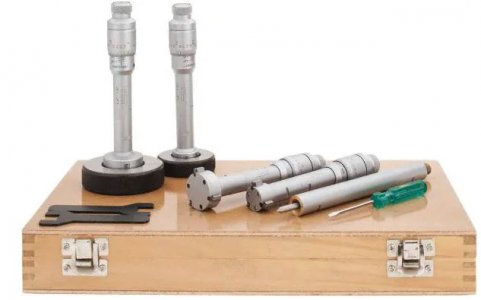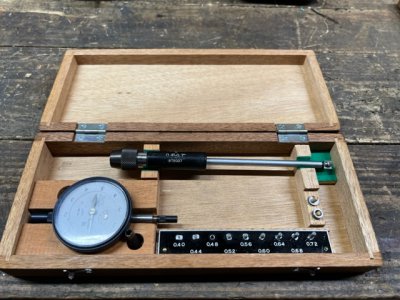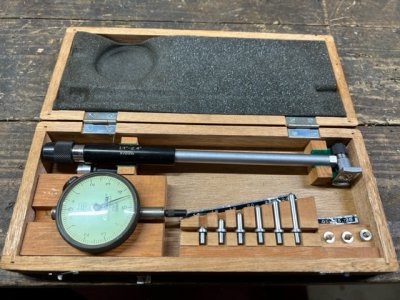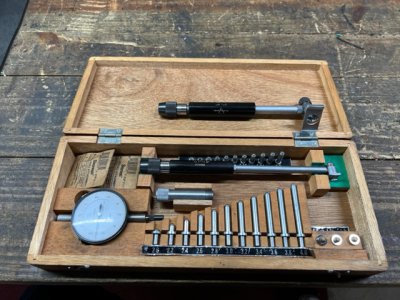-
Welcome back Guest! Did you know you can mentor other members here at H-M? If not, please check out our Relaunch of Hobby Machinist Mentoring Program!
You are using an out of date browser. It may not display this or other websites correctly.
You should upgrade or use an alternative browser.
You should upgrade or use an alternative browser.
Fitting a bronze bushing using a telescoping bore gauge
- Thread starter WaltDizzy
- Start date
Thanks to everyone who took the time to reply.
I think the telescoping bore gauges are a great tool for those of us who are looking for a way to perform high-precision hole measurements without spending a lot of money on instruments. However, the on-line instruction is difficult to interpret, possibly because describing how the gauge interacts with a micrometer involves a subjective description: my "drag" might be the same as another person's "barely touching".
At any rate, my conclusion (from N=2 sets of experiments), is for the way I work, telescoping gauges measure slightly undersize if I set the micrometer to barely touch the center of the gauge anvils. I get a more accurate measurement if I rotate the gauge through the micrometer anvils.
I think it's also worth confirming that performing a spring boring pass with a slow feed rate prior to measuring has got to be a good idea.
Finally, wow! It's hard to describe how gratifying it was to push the bushings into place and have them fit correctly: they were just a little too tight to start with finger pressure, then they went in most of the way using a lightweight bicycle bearing press, then they got really tight and I had to seat them using my mill vise. I have confidence I have improved my lathe, and that the repair will hold up for a long time. You can't buy an experience like that!
Walt
I think the telescoping bore gauges are a great tool for those of us who are looking for a way to perform high-precision hole measurements without spending a lot of money on instruments. However, the on-line instruction is difficult to interpret, possibly because describing how the gauge interacts with a micrometer involves a subjective description: my "drag" might be the same as another person's "barely touching".
At any rate, my conclusion (from N=2 sets of experiments), is for the way I work, telescoping gauges measure slightly undersize if I set the micrometer to barely touch the center of the gauge anvils. I get a more accurate measurement if I rotate the gauge through the micrometer anvils.
I think it's also worth confirming that performing a spring boring pass with a slow feed rate prior to measuring has got to be a good idea.
Finally, wow! It's hard to describe how gratifying it was to push the bushings into place and have them fit correctly: they were just a little too tight to start with finger pressure, then they went in most of the way using a lightweight bicycle bearing press, then they got really tight and I had to seat them using my mill vise. I have confidence I have improved my lathe, and that the repair will hold up for a long time. You can't buy an experience like that!
Walt
I invested in a few master bores, used for calibrating instruments. These are surprisingly affordable on ebay. These are good for practice, practice, practice.
For my not-so-expensive telescoping bore gauges (which I've had for many years), I have to adjust the tension super carefully. But the right tension for the bore is not the right tension for the mic. So, I tension it so that rolling it through the bore keeps it at the shortest position, but then give the screw a bit of extra crank before measuring with the micrometer. And yes to using a micrometer stand--I found a cheap one on ebay and it's a game-changer for lots of measurements.
As far as tension goes, we all know that the parts and tools we use wind up like springs under stress. The question is how much? If I feel the springiness of the bore gauge when rolling it across the inside of the bore, then the tension screw is too tight. If the only deflection I feel is the gooey bits of my fingers, that's about right. If I don't feel even that, it's probably rattling in the bore being measured. Likewise, when I use the micrometer, the only spring action I want to feel is the pad of my fingers, not in the steel of the part or mic. Thinking about that might make practice more productive.
When I can get ten out of ten measurements in a master bore (each one starting from scratch, maybe even on different days) within a few tenths, I think I have enough practice to make a real measurement I can trust. In the music world, we say that amateurs practice to get it right once, while pros practice so they can't get it wrong.
Of course, the real pros don't use telescoping gauges unless they have to--they have three-point direct-reading bore gauges in the appropriate range of sizes. Few of us can afford that solution, of course.
Rick "looking for a good inside micrometer for small bores" Denney
For my not-so-expensive telescoping bore gauges (which I've had for many years), I have to adjust the tension super carefully. But the right tension for the bore is not the right tension for the mic. So, I tension it so that rolling it through the bore keeps it at the shortest position, but then give the screw a bit of extra crank before measuring with the micrometer. And yes to using a micrometer stand--I found a cheap one on ebay and it's a game-changer for lots of measurements.
As far as tension goes, we all know that the parts and tools we use wind up like springs under stress. The question is how much? If I feel the springiness of the bore gauge when rolling it across the inside of the bore, then the tension screw is too tight. If the only deflection I feel is the gooey bits of my fingers, that's about right. If I don't feel even that, it's probably rattling in the bore being measured. Likewise, when I use the micrometer, the only spring action I want to feel is the pad of my fingers, not in the steel of the part or mic. Thinking about that might make practice more productive.
When I can get ten out of ten measurements in a master bore (each one starting from scratch, maybe even on different days) within a few tenths, I think I have enough practice to make a real measurement I can trust. In the music world, we say that amateurs practice to get it right once, while pros practice so they can't get it wrong.
Of course, the real pros don't use telescoping gauges unless they have to--they have three-point direct-reading bore gauges in the appropriate range of sizes. Few of us can afford that solution, of course.
Rick "looking for a good inside micrometer for small bores" Denney
- Joined
- Dec 2, 2012
- Messages
- 1,723
For my not-so-expensive telescoping bore gauges (which I've had for many years), I have to adjust the tension super carefully. But the right tension for the bore is not the right tension for the mic.
I tried a very cheep set of telescope gauges , they gave me a bad impression of telescoping gauges early on.
I attempted to improve the finish on them but basically mine were unsaveable , I got a second hand set of mitutoyo ones from ebay and was amazed by the ease of use. The surface finish allowed them to slip easily and repeatably whilst the clamping was night and day compared to the real cheep off brand ones I had.
Stu.
Three point Bore Gauges, (Intra-mikes), are great IF . . . . the bore is round. And yes, buy Quality telescoping gauges. B & S, Lufkin, Mitutoyo, Starrett.I invested in a few master bores, used for calibrating instruments. These are surprisingly affordable on ebay. These are good for practice, practice, practice.
For my not-so-expensive telescoping bore gauges (which I've had for many years), I have to adjust the tension super carefully. But the right tension for the bore is not the right tension for the mic. So, I tension it so that rolling it through the bore keeps it at the shortest position, but then give the screw a bit of extra crank before measuring with the micrometer. And yes to using a micrometer stand--I found a cheap one on ebay and it's a game-changer for lots of measurements.
As far as tension goes, we all know that the parts and tools we use wind up like springs under stress. The question is how much? If I feel the springiness of the bore gauge when rolling it across the inside of the bore, then the tension screw is too tight. If the only deflection I feel is the gooey bits of my fingers, that's about right. If I don't feel even that, it's probably rattling in the bore being measured. Likewise, when I use the micrometer, the only spring action I want to feel is the pad of my fingers, not in the steel of the part or mic. Thinking about that might make practice more productive.
When I can get ten out of ten measurements in a master bore (each one starting from scratch, maybe even on different days) within a few tenths, I think I have enough practice to make a real measurement I can trust. In the music world, we say that amateurs practice to get it right once, while pros practice so they can't get it wrong.
Of course, the real pros don't use telescoping gauges unless they have to--they have three-point direct-reading bore gauges in the appropriate range of sizes. Few of us can afford that solution, of course.
Rick "looking for a good inside micrometer for small bores" Denney
- Joined
- Apr 14, 2014
- Messages
- 3,156
Another option for bore gauges is what I would refer to as a "single point" bore gauge. They come in a variety of sizes and since they only measure the bore at a single point per pass you can use them on just about any shape bore. They are generally more expensive than the snap gauges, but less expensive than the three-point style.
I picked up these three sets last year from a used equipment dealer for less than $100.00. The indicator heads are interchangable with almost any popular brand. In this case I have imperial heads on all three, but they can be changed out for metrics in less than a minute. These 3 gauges can cover bores from .040" to 6.00"
I picked up these three sets last year from a used equipment dealer for less than $100.00. The indicator heads are interchangable with almost any popular brand. In this case I have imperial heads on all three, but they can be changed out for metrics in less than a minute. These 3 gauges can cover bores from .040" to 6.00"
Attachments
- Joined
- Mar 14, 2022
- Messages
- 696
Those are very similar to the 2.0"-6.0" set I have. With a Federal .0001" indicator. Perfect for checking cylinder-to-piston skirt clearance. Gave less than $50 (?) for them, and checked them with the masters in the lab where I worked at the time. One of the best tools I ever brought.Another option for bore gauges is what I would refer to as a "single point" bore gauge. They come in a variety of sizes and since they only measure the bore at a single point per pass you can use them on just about any shape bore. They are generally more expensive than the snap gauges, but less expensive than the three-point style.
I picked up these three sets last year from a used equipment dealer for less than $100.00. The indicator heads are interchangable with almost any popular brand. In this case I have imperial heads on all three, but they can be changed out for metrics in less than a minute. These 3 gauges can cover bores from .040" to 6.00"
If the bore isn't round, the telescoping gauges are not going to be any better. They might actually be worse.Three point Bore Gauges, (Intra-mikes), are great IF . . . . the bore is round. And yes, buy Quality telescoping gauges. B & S, Lufkin, Mitutoyo, Starrett.
I'm not talking about comparison dial-indicator bore-measuring devices, which are calibrated to a measurement using an outside mic and then used to compare bores to the calibrated value using a built-in dial indicator. I'm talking about direct-measuring three-point inside mics. I have a cheapie set of those, too, and find telescoping gauges to be easier to use.
Even this relatively cheap set of inside bore mics is over a grand at MSC, and not much less used.

Rick "measured a lot of bearing bores in his day" Denney




